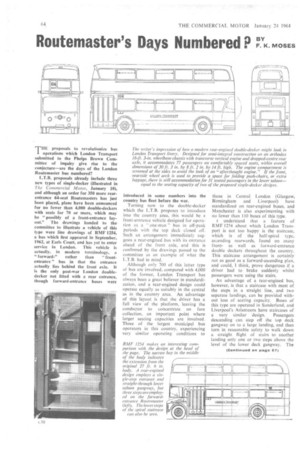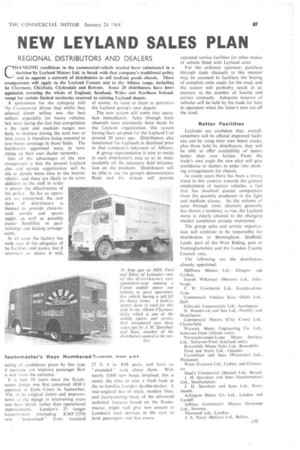Routemaster's Days Numbered P i rk MOSES T HE proposals to revolutionize bus
Page 66

Page 69

If you've noticed an error in this article please click here to report it so we can fix it.
operations which London Transport submitted to the Phelps Brown Committee of inquiry give rise to the conjecture—are the days of the London Routemaster bus numbered?
L.T.B. proposals already include three new types of single-decker (illustrated in The Commercial Motor, January 10), and although an order for 350 more rearentrance 64-seat Routemasters has just been placed, plans have been announced for no fewer than 4,000 double-deckers with seats for 70 or more, which may be "possibly of a front-entrance layout." The drawings handed to thecommittee to illustrate a vehicle of this type were line drawings of RMF 1254, a bus which first appeared in September, 1962, at Earls Court, and has yet to enter service in London. This vehicle is actually, in modern terminology, a "forward-" rather than " frontentrance " bus in that the entrance actually lies behind the front axle. It is the only post-war London doubledecker not fitted with a rear entrance, though forward-entrance buses were
introduced in some numbers into the country bus fleet before the war.
Turning now to the double-decker which the L.T.B. proposes to introduce into the country area, this would be a front-entrance vehicle designed for operation as a "one-man" bus in off-peak periods with the top deck closed off. Such an arrangement immediately suggests a rear-engined bus with its entrance ahead of the front axle, and this is confirmed by the drawings passed to the committee as an example of what the L.T.B. had in mind.
Although only 700 of this latter type of bus are involved, compared with 4,000 of the former, London Transport has always been a great believer in standardization, and a rear-engined design could operate equally as suitably in the central as in the country area. An advantage of this layout is that the driver has a full view of the platform, leaving the conductor to concentrate on fare collection, an important point where larger seating capacities are involved. Three or the largest municipal bus operators in this country, experiencing very similar operating conditions to
RMF 1254 makes an interesting comparison with the design at the head of the page. The narrow bay in the middle
of the body indicates the extension from the original 27 ft. 6 in. body. A rear-engined design employs a single-step entrance and straight-through lower saloon gangway, but three steps are employed on the forwardentrance Routemaster (left). The lowersteps of the spiral staircase
can also be seen.
those in Central London (Glasgow, Birmingham and Liverpool) have standardized on rear-engined buses, and Manchester is also experimenting with no fewer than 110 buses of this type.
I understand that a feature of RMF 1254 about which London Transport is not too happy is the staircase, which is of the half-spiral type, ascending rearwards, found on many frontas well as forward-entrance double deckers throughout the country. This staircase arrangement is certainly not as good as a forward-ascending plan, and could, I think, prove dangerous if a driver had to brake suddenly whilst passengers were using the stairs.
An advantage of a rear-engined bus, however, is that a staircase with most of the steps in a straight line, and two separate landings, can be provided without loss of seating capacity. Buses of this type are operated in Sunderland, and Liverpool's Atlanteans have staircases of a very similar design. Passengers descending can step off the top deck gangway on to a large landing, and then turn in reasonable safety to walk down a straight flight of stairs to another landing only one or two steps above the level of the lower deck gangway. The eeling of confidence given by this type if staircase can improve passenger flow o and from the entrance.
It is now 10 years since the Routenaster design was first conceived (RM 1 [poem-cc] at Earls Court in September, 954. ill its original form) and improvenents to the design in intervening years lave been detail, rather than operational mprovements. London's 25 longer
toutemasters (including RMF 1254) vere improvised " from standard 27 ft. 6 in. RM parts. and have an ."
extended" look about them. With nearly 5,000 new buses involved, this is surely the time to take a fresh look at the so-familiar London double-decker, A rear-engined bus of sleek, modern lines, and incorporating many of the advanced, technical features found on the Routemaster, might well give new esteem to London's road services in the eyes of both passengers and bus crews.
























































































































